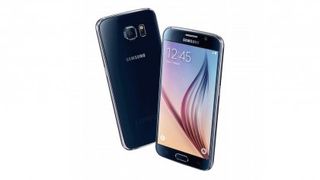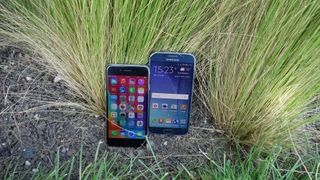
When the Samsung Galaxy S6 launched, its closest Apple rival was the iPhone 6. That was a while ago and the Cupertino firm has since updated its range with the iPhone 6S, while Samsung has updated its range with the Galaxy S7 and Galaxy S7 Edge.
Neither the iPhone 6 or Samsung Galaxy S6 have disappeared though. In fact, both phones are now cheaper as the iPhone 6S and Galaxy S7 both sport the original lofty price tag.
Be sure to read our iPhone 6S vs Galaxy S7 comparison for the latest phones - but let's first take a quick look at the cheaper phones and see which one is worth your while.
- You should read: iPhone 6S vs Samsung Galaxy S6
At a time when the choice between these two smartphone platforms arguably comes down to personal preference more than how much you can afford or obvious feature deficiencies, that makes a detailed comparison all the more essential.
A close look at these two phones side by side yields more fascinating differences than suspicious similarities. What's undeniable, though, is that they're both gunning for a similar premium market.
Both have classy metal-and-glass designs, class-leading cameras, and powerful processors - but their top-end price tags have dropped.
Both phones also mark sizeable departures from their predecessors. In the iPhone 6, which was launched in September 2014, Apple finally ditched the restrictive and arguably outmoded 4-inch display size of previous iterations.
Get daily insight, inspiration and deals in your inbox
Get the hottest deals available in your inbox plus news, reviews, opinion, analysis and more from the TechRadar team.

It also switched away from the striking square-rim design language that had been part of the iPhone range ever since the iPhone 4 in 2011, returning to a softer and more rounded approach that's reminiscent of earlier handsets.
Samsung's design overhaul has been even more radical. The Samsung Galaxy S6, launched in April 2015, marked a fundamental change in philosophy for the South Korean manufacturer.
Gone is the function-over-form mantra, the gaudy-but-robust plastic construction, the emphasis on box-ticking gimmick overload ahead of a crafted user experience. In its place is an elegant handset that concerns itself with how pleasant it is to live with rather than how many things it can do.
Samsung even went as far as to make a variant of the S6 in the form of the Galaxy S6 Edge, with curved dual displays for an even more premium look and feel.
Then there's also the elephant in the room - the Samsung Galaxy S7. Samsung has announced the Galaxy S7 and Galaxy S7 Edge, and in our reviews we called them the best phones in the world right now.
A lot has changed since the Galaxy S6, but it also makes sure that the Galaxy S6 is an even cheaper choice now. We love the Galaxy S7, but the Galaxy S6 is still a great phone so it's worth taking a look at how it compares before you just jump on Samsung's latest.
- Full reviews: Samsung Galaxy S6 | iPhone 6
Watch our video review of the iPhone 6 - and stay tuned for the Samsung Galaxy S6 below.
Key features
The parallels between these two major phones can be be seen by breaking them down into their key selling points. In this respect, at least, it can be said that the iPhone 6 and Samsung Galaxy S6 precisely mirror one another.
After all, both phones sell themselves on sleek new designs, improved screen technology, and stellar cameras.
And yet, in each key respect, the two phones take a very different approach, as we'll discuss in greater detail in the appropriate sections.
In isolation, the iPhone 6's design is notable for marking a big departure from the iPhone 5S before it. It's bigger, slimmer, and more rounded, and it reverts to the gentle curves of the iPhone 3GS after a prolonged spell of palm-grating angles.

Samsung's phone, meanwhile, marks a radical rejection of the plastic and faux-leather effects typified by the Samsung Galaxy S5. In its place we have a metal rim and two shiny glass surfaces.
Yes, Samsung has evidently learned a thing or two from Apple in this regard, but as we'll discuss in the next section it's not quite as blatant as you might think.
Both phones represent notable leaps forward in screen technology, too, but in very different ways. The iPhone 6 marks Apple's belated realisation that a lot of people quite like larger phones. As such, its display has grown 0.7 of an inch over its predecessor's.
That doesn't sound like a lot - and indeed, in Android terms it would still be seen as a 'mini' phone - but it instantly makes the iPhone a much better multimedia device than before.
It's not the sharpest display we've ever seen, though. With an unusual 1334 x 750 resolution, it produces the exact same pixel density of 326ppi as previous iPhones.
In everyday use this is actually perfectly fine. Thanks to Apple's tight hold on its software, everything feels optimised and native on this display, unlike on many 720p Android phones that we could mention.

Still, we imagine plenty of industry-aware Apple fans will wince when they spot the Galaxy S6 display's vital statistics. It's a 5.1-inch QHD Super Amoled display, which offers a whole heap of advantages over the iPhone 6 equivalent.
For one thing, it's about half an inch bigger, meaning that websites and media content are larger and clearer. Also, QHD means that the display has a 2560 x 1440 resolution. We're talking something not too far shy of four times the number of pixels found in the iPhone 6, and a 577ppi pixel density that's almost double.
Honestly, in general usage, the difference simply doesn't feel that pronounced. There's still much debate over the need for a QHD resolution in smartphone displays.
That doesn't mean that you can't see the benefits at all, though. Running the same 4K or 2K video side by side on each, you can undoubtedly pick up more detail in the Galaxy S6. The same advantage sees viewing high quality photos on the Samsung a superior experience.

As for the differences between Super AMOLED and LCD, well, those are a little more subjective. The Galaxy S6 screen has colours that pop more, deeper blacks, yet a generally redder tinge to it. The iPhone 6's screen is colder and bluer.
Looking at the TechRadar homepage on both, with its whites and greys, the Galaxy S6 looked surprisingly murky and tinted by comparison. It's not, of course. In fact, the Galaxy S6 gets incredibly close to the 6500K reference standard for colour accuracy, while the iPhone 6 comes in well above that level.
But if you've become used to Apple's distinctive blue tint, and particularly its icy whites, the difference can be jarring.
The iPhone 6 screen also comes across as brighter than its larger, sharper rival. It's one of those rare phones that can make the S6 seem almost muted. It means that holding the two screens side-by-side isn't the knocked-out-of-the-park win for the Samsung that we were expecting.
Finally, both phone manufacturers have pushed their handsets' photographic chops as a major selling point. Both manufacturers are quite right to do so.

These are two phenomenal camera phones, both capable of replacing all but the best dedicated point and shoot cameras in terms of image quality - and any camera you care to mention in terms of ease of use and speed of operation.
The iPhone 6 camera is an 8MP example with phase detection autofocus, making for super-snappy snaps.
As elsewhere, the Galaxy S6 outspecs the iPhone 6 on the camera front. It's a 16MP unit which also comes with phase detection technology, as well as a bunch of additional features like OIS for steadier shots.
We'll go into the details in the appropriate section, suffice to say that the Galaxy S6 offers the first genuine rival to the iPhone range on the camera front in years. It's arguably the more sophisticated camera, too, with more functions and options for advanced shooters.
We still love the iPhone 6's solid, dependable point-and-shoot nature, though. When it comes to firing and forgetting, there's still nothing better.
Like we said at the outset, these two flagship phones set out with similar basic intentions, but go about executing in surprisingly different ways. What's undoubtable is that both have arrived more or less where they wanted to be right near the top of the smartphone tree.
Now watch our video review of the Samsung Galaxy S6.
